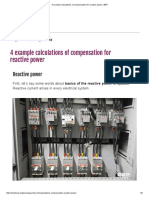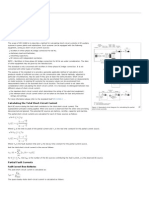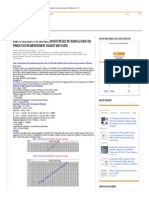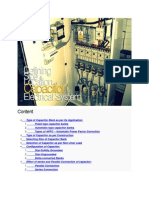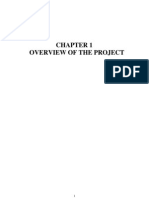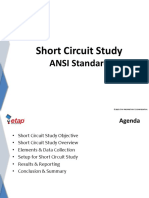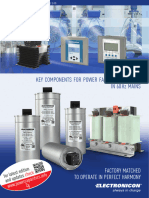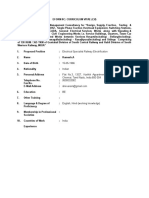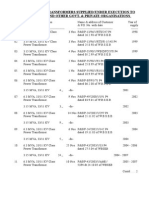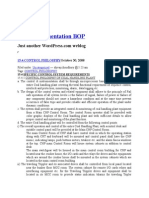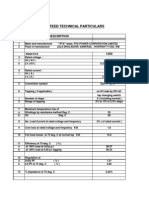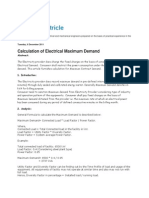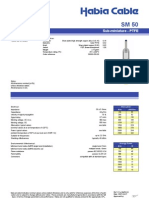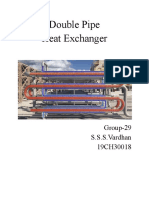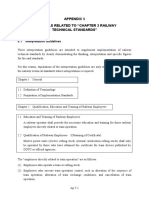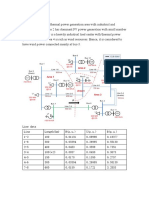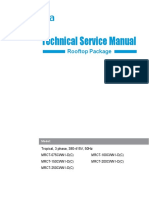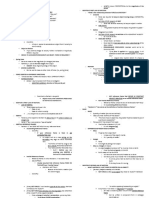Power Factor & APFC
�What is power factor?
Power Factor = Active Power (kW)/Apparent Power (kVA)
PF1.0
Usually P.F is always Lag (Inductive)
Some time P.F can be Lead (Capacitive).
�Origin of Low Power Factor
Electrical Equipment need Reactive Power
Inductive loads draw Reactive Power
Phase difference between current & Voltage
reduces Displacement PF.
Reactive Power to maintain magnetic fields
in Motors.
Non-Linear loads reduces Distortion PF.
True PF, being product of displacement and
distortion PF is lower than both.
Capacitors can only improve displacement PF.
3
�Disadvantages of low power factor
Inefficient use of Electrical Energy:
Overloading of Transformer/Generator;
Overloading of Cable, Switchgear, Busbar
Higher temperature due to increased losses
Imposes larger kVA demand
Limits No. of loads that can be connected
Reduced revenue to Electrical Utilities
Poor Voltage regulation
�Power Factor
Correction
Reactive Current
(capacitive) IR(C)
I=Active Current
1
Reactive Current
(inductive) IR(L)
V= Line Voltage
2
I2
I1
�Advantages of P.F
Correction
Reduction in
Switchgear
Rating
Reduction in KVAR
Demand
Reduction in
Cable / Bus-bar
size
Reduction in KVA
Demand
Reduction in KVA
Demand
Reduction in Line
Current
Avoid power factor
penalties
Reduction in
Transformer Rating
Reduction in Line
loss
�ESTIMATION OF kVAr REQUIRED
for New Electrical Installations
500kVA, 11kV/415V,
%Impedance = 4.25%
75 HP, Other loads,
30 HP,
(415V, (total of 25
(415V,
3ph,
Kw)
3ph, I M pf
compressor
0.7)
pf. 0.7)
20 HP,
50 kVA,
75 HP,
(415V,
(440V,
(415V,
3ph,
3ph,
3ph,
UPS)
compressor) Pump,
PF =0.70
Lag)
M
Lighting
(Load
10kW)
Let us assume that the target Power Factor as desired by the Customer is
0.95.
�Kvar For The Supply TransformerFor 500 kVA transformer, kVAr = 30 kVAr
Kvar For Induction Motorrating of motor = 200 HP x 0.746
= 150 kW
Kvar for motor = 150*[tan(cos-1(0.95)- tan(cos-1(0.99)]
= 104 Kvar
Kvar For UPSrating of UPS = 50 KVA* 0.7
= 35 Kw
Kvar for UPS = 35 [tan(cos-1(0.70)- tan(cos-1(0.99)]
= 25 Kvar
Kvar For Others & lighting loadKvar for UPS = 24 [tan(cos-1(0.70)- tan(cos-1(0.99)]
= 17 Kvar
Total kvar requirement = (30+104+35+25+17)kvar =211 Kvar
Assuming 15% design assumption and contigency = 221*0.15=31.65 Kvar
Total kvar = 242.65 kvar
Kavr recommended= 250 kvar
Capacitor req. (c) = Qc/V2(2f)
Hence Capacitor req. for UPF=106*250/(2302*100)
8
= 150.51F.
�Type of compensation
1. Individual compensation
2. Group compensation
3. Central compensation
Fixed compensation
- Steady Loads
No load compensation of Induction Motors
No load compensation of Transformers
Variable compensation(for varying loads)- APFC
Svc
�Disadvantages of fixed capacitor
Manual operation(on/off)
Not meet the require kvar under varying
loads.
Can result leading power factor
Cause over voltage
Mal-operation of relays, diesel generators
Saturation of transformer
Penalty by electricity authority
10
�NEED FOR AUTOMATIC POWER FACTOR
CORRECTION
varying power demand on the supply system.
power factor also varies as a function of the load requirements.
difficult to maintain a consistent power factor by use of Fixed
Compensation i.e. fixed capacitors.
leading power
compensation)
factor
under
light
load
conditions(fixed
This result in over voltages, saturation of transformers, maloperation of diesel generating sets, penalties by electric supply
authorities.
automatically variation, without manual intervention, the compensation to
suit the load requirements.
Automatic Power Factor Correction(APFC) system provide this facility.
leading power factor will be also prevented.
11
�Benefits of APFC
Consistently high power factor under fluctuating loads
Prevention of leading power factor
Eliminate power factor penalty
Lower energy consumption by reducing losses.
Continuously sense and monitor load
Automatically switch on/off relevant capacitors steps for
consistent power factor.
Ensures easy user interface
Protect under any internal fault
Advance - relay with communication facility
Used MPP-H/MD-XL/FF(APP) type capacitors
User friendly, aesthetecally designed enclosure, dust and vermin
proof.
12
�Automatic Power Factor Correction
(APFC):
Capacitors grouped into several steps.
Suitable switching devices with coupled with
inrush current limiting devices are provided for
each step
Power Factor sensed by CT in line side
kVAr required to achieve target PF is computed
by the Microprocessor based APFC relay
APFC relay switches appropriate capacitor steps
CT senses improved PF and gives feedback
Thus target PF is achieved
13
�How to Improve Power Factor Without
Causing Harmonic Problem ?
Conventional capacitors should not be used.
Capacitors should be replaced by harmonic suppression filters
(series combination of suitable series reactor & capacitors) so
that,
It offers capacitive reactance at fundamental frequency for
necessary power factor correction.
It offers inductive reactance at all higher order dominant
harmonic frequencies to avoid resonance.
Its self series resonance frequency fR do not coincide with
predominant harmonics.
14
�Network With Harmonic
Filters
GRID
ZN
No resonance at harmonic frequencies
as filter is inductive at such
frequencies
ZT
Harmonic currents flow towards Grid ,
as it offers least impedance compared
to filter
BUS
L
Non Linear
Load
M
Equivalent Load
Impedance ZL
Predominantly fundamental current
flows through Capacitors
Moderate THD(V) in the Bus
No harmonic overloading of
Capacitors
Improvement in Power Factor
without Harmonic overload
15
�Qkvar
Degree Of Protection IP20
Ambient temperature
Voltage rise should be 3.0% [% Vc = (Q kvar
*%X)/(kva)]
Voltage rise due to series reactor and harmonics
Size of individual capacitor banks (step requirement)
Directly connected Discharge Device(Resistor, VT)
to discharge the capacitor to reduce voltage to 50
Specification of capacitors in APFC
volts within one minute
16
�Selection of switching equipment
FOR LT
Switch- fuse units/CBs/ Thyristers
Switch should be quick make and break type
Rating of CB, contactors, fuse and cable should be130% of
capacitor rated current.
For automatic switching, each step capacitor should be provided
with fuse and contactor.
FOR HT
Ht capacitor is connected to bus by CB
Cb rating should be maximum operating voltage of circuit
Continuous current rating of CB should be 135% of rated
capacitor bank current
17
H=Kp 1 (converter) where k= 1,2,3,4,.
p= pulsating index
High Harmonics current produces high harmonics
voltages.
When harminics current frequency and parrellel
resonance become equal than corrosponding
harmonics voltage produces over current in
capacitor.
Harmonics and parallel resonance
18
�XT= Xc/h2
Supress high inrush current to safe value at
time of capacitor switching.
Improve voltage waveform
Reactor should be able to carry 135%of rated
contineous current.
Discharge VT
To discharge voltage of capacitor
Series reactor
19
�TYPES OF CAPACITOR TECHNOLOGIES
MPP - METALLISED POLYPROPYLENE
MD - MIXED DIELECTRIC
FF/ALL PP - FILM - FOIL OR ALL POLY
PROPELENE
MD -XL - MIXED DIELECTRIC LOW LOSS
20
�METALISED POLYPROPELENE CAPACITOR
MPP - METALLISED
POLYPROPELENE
METALLISED LAYER
METALISATION HAS BEEN DONE ON
ONE SIDE OF POLY PROPELENE
FILM AND USED FOR CAPACITOR
WINDING
ECNOMICAL AND COMPETITIVE
DESIGN
MPP-S - NORMAL DUTY
MPP-H - MEDIUM DUTY
PP FILM
21
�MIXED DIELECTRIC TYPE
MD - MIXED DIELECTRIC
PP FILM, FOIL AND PAPER ARE USED TO
PAPER
FORM CAPACITOR WINDING
PP FILM
FOIL
22
�FILM FOIL OR APP
FILM FOIL OR APP - ALL POLY
PROPELENE
METAL LAYER IS PLACED IN -
PP FILM
BETWEEN PP FILM TO FORM
CAPACITOR WINDING
PP FILM
FOIL
23
�FILM FOIL OR APP
FILM FOIL OR APP - ALL POLY
PROPELENE
PP FILM
METAL LAYER IS PLACED IN -
BETWEEN PP FILM TO FORM
CAPACITOR WINDING
PP FILM
FOIL
24
�MIXED DIELECTRIC - LOW
LOSS
MD-XL - MIXED DIELECTRIC LOW LOSS
DOUBLE SIDE METALLISED
PAPER
PP FILM AND DOUBLE SIDED
METALISED FILM ARE USED TO FORM
CAPACITOR WINDING
PP FILM
25
�Film foil/APP verses Mixed
dielectric comparison
Film foil/APP
Mixed dielectric
low dielectric watt loss
High dielectric watt loss
Film not impregnable
Paper impregnable
More prone to Self healing
less prone to Self healing
Inferior long term stability
Superior long term stability
Moderate harmonic overload
Good harmonic overload
capability
capability
26
�Mixed dielectric verses MDXL
Comparison
Mixed dielectric
MDXL
High dielectric watt loss
Lowest dielectric watt loss
Paper impregnable
Combines plus points of MD
less prone to Self healing
and APP types
Superior long term stability
Excellent long term stability
Good harmonic overload
Superior harmonic overload
capability
capability
27
�APFC
28
�29
�30
percentage of Non linear loads in an
installation becomes greater than 20% of
connected load.
N/w Harmonics
Overloading cap
Conventional
capacitor
Current amp
Cap failure
Power factor correction in
Voltage distortion
harmonics enrich environment
Parallel resonance
31
�solution
Use detuned filter circuit
Avoid parallel resonance by offering inductive impedance to specific
harmonics frequency.
The tuning frequency is generally lower than 90 % of the lowest
harmonic frequency whose amplitude is significant.
Protect capacitors from harmonics over loading
Reduces over loading of transformer and other rotating equipments.
Prevent current amplification
Achieve consistently high power factor.
Can be used as fixed or APFC
32
�COMPONENTS
33
�CONTROLLER
34
�DRY TYPE RESIGN EMBADED
REACTOR
35
�Circuit Diagram
36
�THYRISTER CONTROLLED
VAR
STATCOM
37













